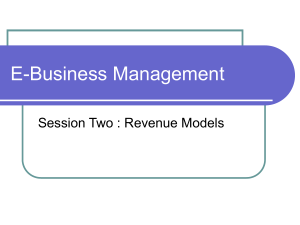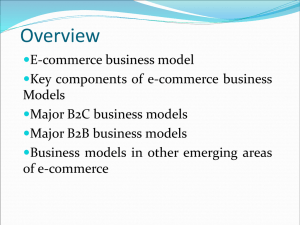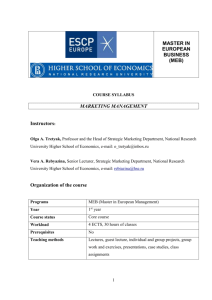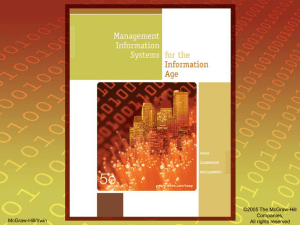Business Model
advertisement
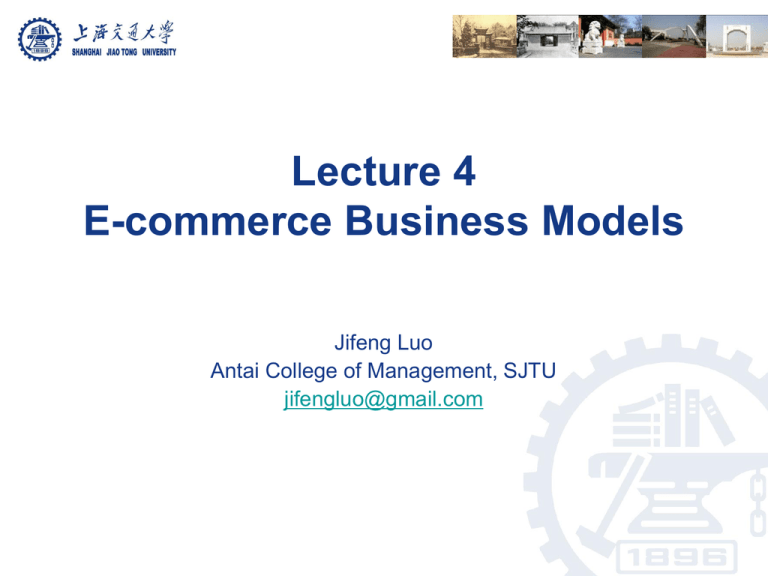
Lecture 4 E-commerce Business Models Jifeng Luo Antai College of Management, SJTU jifengluo@gmail.com E-commerce business models Business Model B2C Business Models B2B Business Models Business Models in emerging areas E-commerce Business Models—Definitions Business model • the architectural configuration of the components of transactions designed to exploit business opportunities Business plan • Describes a firm’s business model E-commerce business model • Uses/leverages unique qualities of Internet and Web Business Model A story of how a business works • the method of doing business by which a company can generate revenue. Needs to pass two critical tests • Narrative test • Numbers test Think of business modeling as the managerial equivalent of the scientific method - you start with a hypothesis, which you then test in action and revise when necessary. At the end of the day, the business model should be condensed onto one page Strategy vs. Business Model Strategy = Business Model? • Business models describe, as a system, how the pieces of a business fit together. But they don’t factor in one critical dimension of performance: competition. • Sooner or later—and it is usually sooner—every enterprise runs into competitors. Dealing with that reality is strategy’s job. A competitive strategy explains how you will do better than your rivals. • A firm’s strategy is deeply rooted in that particular firm’s competitive environment. Which comes first: strategy or business model Case: strategy vs. business model Although you may think that Wal-Mart pioneered a new business model on its road to success, the reality is that the model was really no different than the one Kmart was using at the time. But it was what Sam Walton chose to do differently than Kmart, such as focusing on small towns as opposed to large cities and everyday low prices, that was the real reason for his success. Although Sam Walton’s model was the same as Kmart's, his unique strategy made him a success. Key Ingredients of a Business Model segment marketing Value Proposition Defines how a company’s product or service fulfills the needs of customers Questions to ask: • Why will customers choose to do business with your firm instead of another? • What will your firm provide that others do not or cannot? Examples of successful value propositions: • Personalization/customization • Reduction of product search, price discovery costs • Facilitation of transactions by managing product delivery Revenue Model Describes how the firm will earn revenue, generate profits, and produce a superior return on invested capital Major types: • Sales revenue model • Advertising revenue model • Subscription revenue model Micro-payment • Transaction fee revenue model • Affiliate revenue model Intellectual Property Rights Protection Market Segment Refers to a company’s intended market space and overall potential financial opportunities available to the firm in that market space • Market space • Area of actual or potential commercial value in which company intends to operate • Realistic market opportunity • Defined by revenue potential in each of market niches in which company hopes to compete Competitive Environment Refers to the other companies selling similar products and operating in the same market space Influenced by: • • • • Number of active competitors Each competitor’s market share Competitors’ profitability Competitors’ pricing Includes both direct competitors and indirect competitors Competitive Advantage Achieved when a firm can produce a superior product and/or bring product to market at a lower price than most, or all, of competitors • First mover advantage vs. fast follower advantage • Unfair competitive advantage Perfect market: No competitive advantages or asymmetries Leverage: When a company uses its competitive advantage to achieve more advantage in surrounding markets Marketing Strategy Plan that details how a company intends to enter a new market and attract customers Best business concepts will fail if not properly marketed to potential customers Organizational Development Plan that describes how the company will organize the work that needs to be accomplished • Work is typically divided into functional departments • Hiring moves from generalists to specialists as company grows Management Team Employees of the company responsible for making the business model work Strong management team gives instant credibility to outside investors Strong management team may not be able to salvage a weak business model, but should be able to change the model and redefine the business as it becomes necessary Slide 2-15 Business Model Template SWOT Partners Product Core BP Mkting: CR Customer Segment Mkting: Channel Value Proposition Competitive Advantage Cost Finance Revenue [Osterwalder (2010) Business Model Generation] Case: Made.com Made.com Business Model 基础设施 生产组织流程(16位在上海) 采购和物流流程 40多家家具厂商 寻找设计师流程 欧洲的优秀家具 设计师 提供物 低廉的价格 高品质的家具 核心资源: 客户、设计师、 成本结构: 财务 没有中间商、仓库、零售商、库存成本 客户关系: 投票竞赛、购买 客户 客户 渠道通路: 互联网 收入来源: 网上零售 商业模式描述了 企业如何创造价值,传递价值,捕捉价值的 基本原理 [Osterwalder (2010) Business Model Generation] 苹果iPod/iTunes商业模式画布 关键 业务 重要 伙伴 价值 主张 设计师合作 核心 资源 中国家 具厂 众包 品质 运营 软 件 人力资源 实惠 的高 品质 转换成本 渠道 通路 网站 成本结构 人力资 源 生产制 营销与销 售 客户 细分 客户参与 物流采购 设计师 客户 关系 收入来源 销售收入 大众 市场 E-commerce business models Business Model B2C Business Models B2B Business Models Business Models in emerging areas B2C Business Models: Portal Value proposition: a place where consumers start their Web searching and stay a long time to read news, find entertainment, and meet others. Offers powerful search tools plus an integrated package of content and services Typically utilizes a combined subscription/advertising revenues/transaction fee model Today, seen as “destination” site rather than gateway May be general (horizontal) or specialized (vertical) Examples: Yahoo, MSN, AOL, Ask.com, Sina B2C Business Models: E-tailer Online version of traditional retailer Value proposition: sell products online, with lower price (?) and higher convenience Types include: • Virtual merchants • Bricks-and-clicks • Catalog merchants • Manufacturer-direct Low barriers to entry B2C Business Models: Content Provider Value proposition: distribute digital content, information and entertainment, over the Web Typical revenue models: • Subscription (WSJ.com, free headlines and text, charge or subscription for premium content; importance of micropayment system) • Pay for download (itune.com; real.com) • Advertising Variations: • Syndication (youtube.com) • Web aggregators (fatwallet.com, Craigslist/同城网 ) • User-generated (Wikipedia) B2C Business Models: Transaction Broker Processes online transactions for consumers Primary value proposition—saving time and money Typical revenue model—transaction fee Largest industries using this model: • Financial services (Scottrade.com) • Travel services (expedia.com; ctrip.com) • Job placement services (Monster.com, zhaopin.com) B2C Business Models: Market Creator Uses Internet technology to create markets that bring buyers and sellers together Examples: • Priceline • eBay Typically uses a transaction fee revenue model B2C Business Models: Service Provider Offers services online • e.g. Google: Google Maps, Google Docs, dianping, ask.com, Facebook, Dropbox etc. Value proposition • Valuable, convenient, time-saving, low-cost alternatives to traditional service providers (e.g. legal service from Linklaters BlueFlag Revenue models • Subscription fees • One-time payment • Ads B2C Business Models: Community Provider Creates online environment (social network) where people with similar interests can transact and communicate. Value proposition: a fast, convenient, one-stop site where users can focus on their most important concerns and interests, share the experience with friends, and learn more about their own interests. Typical revenue model: Hybrid • Including advertising fees, subscription fees, sales revenues, transaction fees, affiliate fees Examples: • iVillage, 宽带山, 天涯论坛 E-commerce business models Business Model B2C Business Models B2B Business Models Business Models in emerging areas Net Marketplaces Many different ways to classify Net marketplaces such as based on: Pricing mechanism Nature of market served Ownership Another method: Classify Net marketplaces based on their business functionality What businesses buy (direct vs. indirect goods) How business buy (spot purchasing vs. long-term sourcing) Types of Procurement Types of goods purchased • Direct goods: Goods integrally involved in production process • Indirect goods: All other goods not directly involved in production process (MRO goods) Methods of purchasing • Contract purchasing: Involves long-term written agreements to purchase specified products, with agreedupon terms and quality • Spot purchasing: Involves purchase of goods based on immediate needs in larger marketplaces that involve many suppliers Pure Types of Net Marketplaces B2B Business Models: E-distributor Supplies products and services directly to individual businesses Owned by one company seeking to serve many customers. Revenue model: sales of goods Example: Grainger.com – distributor of MRO supplies • Catalog sales and physical distribution centers • Went online in 1995; one-stop shopping is critical Long tail theory vs. winner-take-all E-distributors Most common type of Net marketplace Provide electronic catalogs that represent products of thousands of direct manufacturers Typically independently owned intermediaries that offer industrial customers single source from which to order indirect goods on spot basis Typically operate in horizontal markets because they serve many different industries with products from many different suppliers Example: W.W. Grainger B2B Business Models: Exchanges Value proposition: provide an electronic digital marketplace where suppliers and commercial purchasers can conduct transactions Usually owned by independent firms whose business is making a market Revenue model: Transaction fees Usually serve a single vertical industry Number of exchanges has fallen dramatically in U.S. Why different fates in USA and China? B2B Business Models: E-procurement Value proposition: creates and sells access to digital electronic markets • Includes B2B service providers, application service providers (ASPs) Revenue models: • Transaction fees, usage fees, annual licensing fees Ariba • Software that helps firms organize procurement process by creating mini-digital markets. E-procurement Independently owned intermediaries connecting hundreds of online suppliers offering millions of indirect goods to business firms who pay fees to join the market Typically used for long-term contractual purchasing of indirect goods Expand on business model of e-distributors Typically offer value chain management (VCM) services, such as automation of firm’s entire procurement process on buyer side, automation of selling business processes on seller side Sometimes referred to as many-to-many market Example: Ariba B2B Business Models: Industry Consortia Industry-owned vertical marketplaces that serve specific industries (e.g. automobile, chemical, floral, logging) Enable buyers to purchase direct inputs from limited set of invited participants; long-term contractual purchasing and development of stable relationships • Supply smaller number of companies with product and services relevant to industry • Sponsored by powerful industry players • Strengthen traditional purchasing behavior Exostar: Online trading exchange for aerospace and defense industry Slide 2-38 Net Marketplace Trends B2B Business Models: Private Industrial Networks Digital networks designed to coordinate the flow of communications among firms engaged in business together Single firm network: Most common form • Wal-Mart or P&G Industry-wide networks: Often evolve out of industry associations, a response to single firm network • Agentrics Slide 2-40 What Are Private Industrial Networks? Web-enabled networks for coordination of trans-organizational business processes (collaborative commerce) Range in scope from single firm to entire industry Example: Procter & Gamble Main Types of Internet-Based B2B Commerce Net marketplaces: Bring together potentially thousands of sellers and buyers in single digital marketplace operated over Internet • Transaction-based • Supports many-to-many as well as one-to-many relationships • Alibaba Private industrial networks: Bring together small number of strategic business partner firms that collaborate to develop highly efficient supply chains • • • • Relationship-based Support many-to-one and many-to-few relationships Largest form of B2B e-commerce WalMart’s Retail link Implementation Barriers Difficulties getting suppliers to join; Concerns about sharing of proprietary data (security) Implementation is complex, time consuming and expensive Integration into existing ERP systems and EDI networks (economic, tech, business process change) Requires change in mindset and behavior of employees

